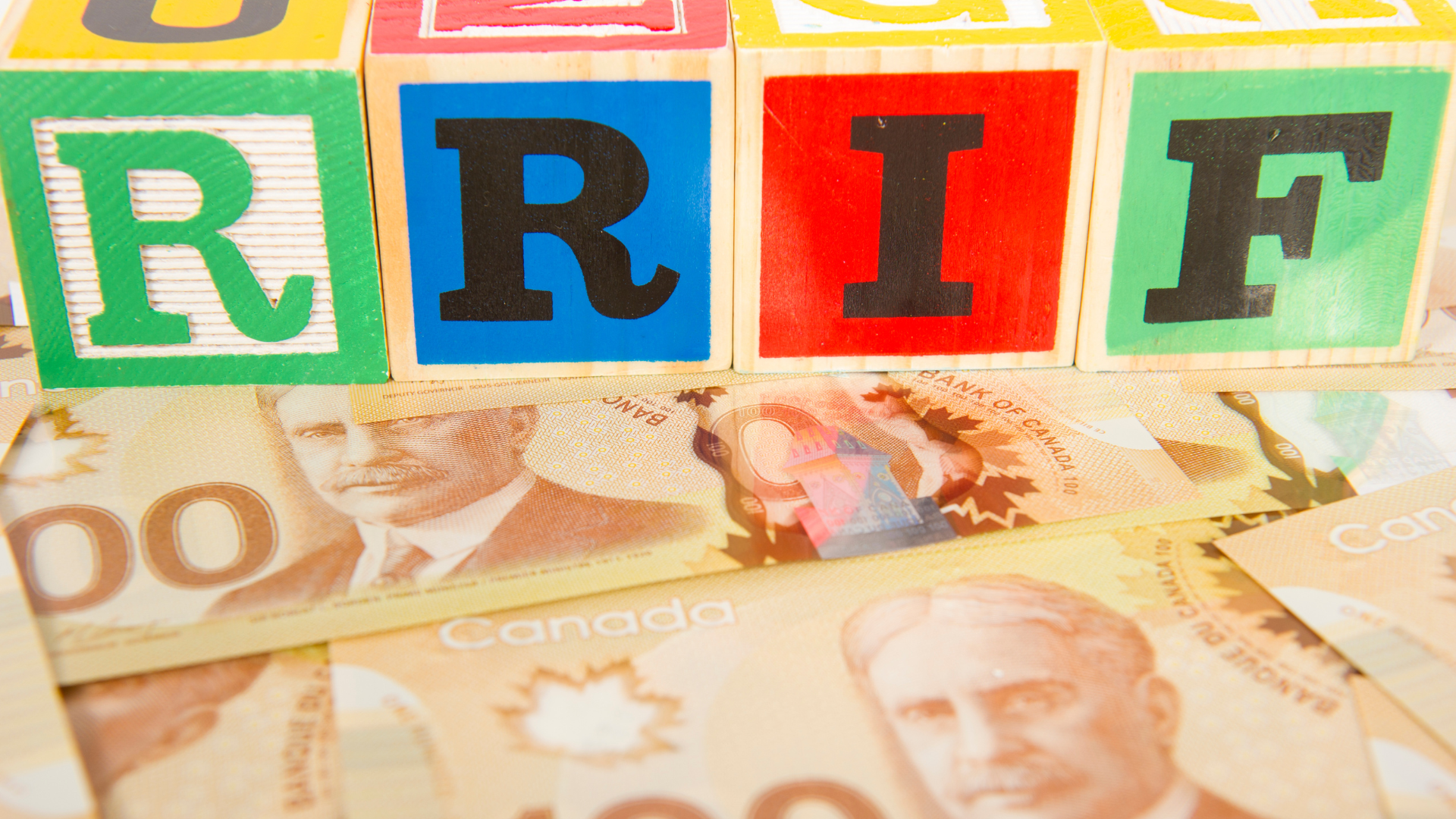Mastering the Art of RRIF Drawdown: An Essential Guide to Optimize Your Retirement Income
This blog will help guide readers through understanding RRIF Drawdown, its implications, and how to optimize their strategy for better retirement income. It caters to a broad audience - from those just beginning to plan for their retirement to those already in their retirement years and wanting to maximize their income.

I. Introduction
In the realm of financial planning and retirement, few terms are as significant yet potentially bewildering as "RRIF Drawdown." For those approaching their golden years, a solid understanding of this concept is not just advantageous, but crucial.
A
Registered Retirement Income Fund (RRIF) drawdown is the annual withdrawal one must make from their RRIF once they've converted their Registered Retirement Savings Plan (RRSP) into this income-generating account. It's essentially a governmental mandate that ensures retirees use their retirement savings for their intended purpose – supporting themselves during retirement. The term "drawdown" refers to the act of gradually withdrawing these funds over time.
Understanding RRIF Drawdown is vital for several reasons. Not only does it help retirees manage their finances more effectively, but it also has considerable implications for tax planning and overall wealth management. Grasping the intricacies of RRIF Drawdown allows individuals to maximize their retirement income while minimizing potential financial risks and tax liabilities.
This guide is designed to shed light on the complex topic of RRIF Drawdown, elucidating its mechanics, strategies, and common pitfalls. Whether you are a seasoned retiree or just beginning to envision your retirement horizon, understanding RRIF Drawdown is a key step in safeguarding your financial health and optimizing your retirement lifestyle.
II. Understanding Registered Retirement Income Fund (RRIF)
A Registered Retirement Income Fund (RRIF) is an investment account designed to provide individuals with a steady income stream during retirement. In essence, it serves as the successor to your Registered Retirement Savings Plan (RRSP), the primary savings vehicle used by Canadians to prepare for retirement.
An RRSP is designed to help you save for retirement by allowing your investments to grow tax-free. However, the government requires that you convert your RRSP into a RRIF by the end of the year in which you turn 71. Once converted into an RRIF, the account maintains its tax-sheltered status, meaning investments within the account continue to grow tax-free. The key difference is that you are now required to make minimum withdrawals each year, known as the RRIF drawdown.
How a RRIF works is fairly straightforward. Each year, starting the year after you convert your RRSP into a RRIF, you must withdraw a minimum amount, which is calculated based on your age and the total value of your RRIF at the beginning of the year. Any income or growth generated by the investments within the RRIF remains tax-free as long as it stays in the account. However, the amounts you withdraw each year are taxable.
The benefits of a RRIF are numerous. It provides you with a consistent income stream in retirement while allowing your investments to continue growing tax-free. It also offers flexibility in terms of investment choices and withdrawal amounts (as long as you meet the minimum).
The connection between RRSPs and RRIFs is fundamental in retirement planning. Your RRSP is where you accumulate retirement savings, and your RRIF is where you draw down those savings to provide income in retirement. Mastering the transition from RRSP to RRIF and optimizing the drawdown strategy can significantly impact your financial security and quality of life in your retirement years.
II. Understanding Registered Retirement Income Fund (RRIF)
A Registered Retirement Income Fund (RRIF) is an investment account designed to provide individuals with a steady income stream during retirement. In essence, it serves as the successor to your Registered Retirement Savings Plan (RRSP), the primary savings vehicle used by Canadians to prepare for retirement.
An RRSP is designed to help you save for retirement by allowing your investments to grow tax-free. However, the government requires that you convert your RRSP into a RRIF by the end of the year in which you turn 71. Once converted into an RRIF, the account maintains its tax-sheltered status, meaning investments within the account continue to grow tax-free. The key difference is that you are now required to make minimum withdrawals each year, known as the RRIF drawdown.
How a RRIF works is fairly straightforward. Each year, starting the year after you convert your RRSP into a RRIF, you must withdraw a minimum amount, which is calculated based on your age and the total value of your RRIF at the beginning of the year. Any income or growth generated by the investments within the RRIF remains tax-free as long as it stays in the account. However, the amounts you withdraw each year are taxable.
The benefits of a RRIF are numerous. It provides you with a consistent income stream in retirement while allowing your investments to continue growing tax-free. It also offers flexibility in terms of investment choices and withdrawal amounts (as long as you meet the minimum).
The connection between RRSPs and RRIFs is fundamental in retirement planning. Your RRSP is where you accumulate retirement savings, and your RRIF is where you draw down those savings to provide income in retirement. Mastering the transition from RRSP to RRIF and optimizing the drawdown strategy can significantly impact your financial security and quality of life in your retirement years.
III. The Mechanics of RRIF Drawdown
Once your RRSP is converted into an RRIF, the drawdown process begins. Each year, you're required to withdraw a minimum amount from your RRIF, known as the minimum withdrawal. The Canada Revenue Agency (CRA) provides a percentage that represents this minimum withdrawal, which varies based on your age at the beginning of the year.
Here's how it works: if you're 71 at the beginning of the year, for example, the minimum withdrawal is 5.28% of your RRIF's value. If you're 80, the rate increases to 6.82%. These rates continue to rise with age, which means you'll be withdrawing larger amounts from your RRIF as you age.
The RRIF drawdown schedule is crucial for several reasons. Firstly, it helps retirees plan their finances for the year, knowing exactly how much they'll be required to withdraw and when. Secondly, this schedule helps retirees optimize their tax planning. While RRIF withdrawals are taxable, understanding the drawdown schedule allows individuals to plan their income in a way that may potentially minimize their overall tax burden.
To better understand the impact of RRIF Drawdown on retirement income, let's consider a case study:
John, aged 72, has a RRIF with a value of $500,000 at the beginning of the year. According to the CRA's minimum withdrawal schedule, he must withdraw at least 5.4% of his RRIF's value this year, equating to $27,000. If John's other sources of income total $45,000, his taxable income for the year would be $72,000.
Suppose in the following year, John's RRIF's value is $480,000 and he's now 73, meaning he must withdraw at least 5.53% (approximately $26,544). If his other income remains the same, his taxable income would be slightly less than the previous year, despite the increased drawdown rate.
As this example illustrates, RRIF Drawdown is a significant factor influencing your retirement income and the taxes you'll pay. This is why understanding RRIF Drawdown mechanics is key to optimizing your retirement finances.
IV. RRIF Drawdown Strategies
When it comes to RRIF Drawdown, there isn't a one-size-fits-all strategy. Different approaches suit different financial situations and retirement goals. However, let's explore some commonly adopted RRIF Drawdown strategies:
- Minimum Withdrawal Strategy: This approach involves only withdrawing the required minimum amount each year. It allows your investments to continue growing tax-free within your RRIF for as long as possible.
- Larger Drawdown Strategy: In this strategy, you withdraw more than the minimum amount, providing you with more income but also potentially increasing your taxable income for the year.
- Regular Income Strategy: Here, you treat your RRIF like a monthly salary, withdrawing regular amounts to provide a steady income stream.
- Deciding on your RRIF Drawdown strategy requires considering several factors:
- Current and Future Income Needs: Your living expenses, lifestyle preferences, and potential unexpected costs should all be factored into how much you withdraw.
- Tax Implications: Larger withdrawals may push you into a higher tax bracket, which could be mitigated by spreading your withdrawals over a longer period.
- Market Conditions: Market volatility can affect the value of your RRIF, which could influence your decision to withdraw more or less than the minimum amount.
- Other Income Sources: Pensions, rental income, or part-time work could supplement your income, reducing the need for larger RRIF withdrawals.
Each strategy comes with its pros and cons:
- Minimum Withdrawal Strategy: This approach maximizes tax-free growth but may not provide enough income if your living costs are high.
- Larger Drawdown Strategy: This provides a higher income but also results in larger tax bills and potentially faster depletion of your retirement savings.
- Regular Income Strategy: This offers a predictable income stream but might not adjust to unexpected expenses or changes in market conditions.
Understanding these strategies and their implications will empower you to make informed decisions that best align with your retirement goals. However, it's advisable to seek guidance from a financial advisor who can provide tailored advice based on your personal circumstances.
V. Tax Implications of RRIF Drawdown
An important aspect to consider during RRIF drawdown is its tax implications. While the growth within your RRIF continues to be tax-sheltered, any withdrawals you make are considered income and are therefore subject to income tax. This tax is applied at your personal income tax rate and is the same type of tax you would pay on employment income or interest from a bank account.
Consider the following strategies for minimizing tax on RRIF Drawdown:
- Spread Out Your Withdrawals: By withdrawing only the minimum required amount each year, you can spread your taxable income across more years, potentially keeping you in a lower tax bracket.
- Tax-efficient Investing: Depending on your financial situation and risk tolerance, it may be beneficial to hold more tax-efficient investments, like stocks and ETFs, in your RRIF, while keeping less tax-efficient investments, like bonds, in tax-sheltered or tax-free accounts.
- Income Splitting: If you have a spouse or common-law partner in a lower tax bracket, you can potentially lower your overall tax bill by transferring up to 50% of your RRIF income to them for tax purposes.
- Timing Your Withdrawals: You can control when to make larger withdrawals. For example, if you expect your income to be lower in certain years, perhaps due to less part-time work or business income, you can plan to withdraw more from your RRIF in those years to take advantage of a lower tax bracket.
- Consider a Tax-Free Savings Account (TFSA): If you don't need all the income from your RRIF for living expenses, consider moving the after-tax portion of your withdrawal into a TFSA, where future growth and withdrawals are tax-free.
- Charitable Donations: Donations to registered charities can lead to tax credits, which can help offset the taxes due on your RRIF withdrawal.
Remember, everyone's financial situation is unique, so it's important to discuss these strategies with a tax professional or financial advisor to find the best approach for you.
VI. RRIF Drawdown in Today's Economic Climate
In the fluctuating economic climate of 2023, it's crucial to consider how market conditions can impact your RRIF Drawdown strategy. With the ebb and flow of interest rates, inflation, and overall market performance, the landscape of retirement income planning constantly evolves.
The impact of current economic conditions on RRIF Drawdown primarily revolves around investment performance within your RRIF. In a thriving market, your RRIF's value could grow significantly, providing a larger pool of funds for drawdown. Conversely, in a bear market, the value could decrease, which might mean your withdrawals represent a higher percentage of your overall fund, potentially depleting your savings faster.
Another consideration is inflation. In periods of high inflation, the purchasing power of your RRIF drawdown may be less than anticipated, which could necessitate higher withdrawals to cover living expenses, leading to increased tax liabilities.
Amidst market volatility, consider the following tips for managing your RRIF Drawdown:
- Diversification: A diversified portfolio can help cushion the impact of market downturns. This means spreading your investments across various asset classes, sectors, and geographical areas.
- Rebalancing: Regular portfolio rebalancing can help ensure your investment strategy aligns with your risk tolerance and financial goals.
- Flexibility: If possible, having the flexibility to adjust your withdrawal amounts based on market conditions and your personal financial situation can be beneficial.
- Professional Advice: A financial advisor can provide expert guidance tailored to your personal circumstances, helping you navigate market volatility while maintaining a suitable RRIF Drawdown strategy.
Remember, retirement income planning, including RRIF Drawdown, is not a set-and-forget task. Regular reviews and adjustments are necessary to adapt to both the economic climate and changes in your personal circumstances.
VII. Common RRIF Drawdown Mistakes to Avoid
Despite the best intentions, it's easy to fall into common pitfalls when managing RRIF Drawdowns. Here are a few mistakes retirees often make, and advice on how to avoid them:
- Neglecting to Plan for Taxes: As RRIF withdrawals are treated as taxable income, not accounting for this in your retirement income planning can result in a higher tax bill than anticipated. To avoid this, factor in the tax implications of RRIF withdrawals when planning your retirement income and consider strategies to minimize taxes.
- Ignoring Market Volatility: The performance of your RRIF is tied to the market. Withdrawing too much during a market downturn can deplete your retirement savings faster than expected. Diversifying your portfolio and maintaining a flexible withdrawal strategy can help mitigate this risk.
- Failing to Adjust for Changing Needs: Your financial needs will likely change throughout your retirement. Sticking rigidly to an initial drawdown plan without allowing for adjustments can lead to financial challenges. Regularly review and adjust your drawdown strategy to align with your current needs and lifestyle.
- Withdrawing Only the Minimum Amount Regardless of Need: While withdrawing only the minimum can be a good strategy for tax planning and preserving retirement savings, it can also result in missed opportunities. If you have a need for additional funds (for travel, major purchases, or financial emergencies), or if your other income sources decrease, it may be wise to withdraw more than the minimum.
- Overlooking the Impact of Inflation: Over time, inflation can erode the purchasing power of your RRIF income. Plan for inflation by considering a drawdown strategy that allows for increasing withdrawals over time.
- Underestimating Longevity: People are living longer, and it's important to ensure your retirement savings last as long as you do. Factor in the possibility of a long life when planning your RRIF Drawdown strategy.
Avoiding these common RRIF Drawdown mistakes involves a blend of sound planning, regular review, and a flexible approach that evolves with your personal circumstances, the economic climate, and the market's performance. Working with a financial advisor can help ensure you're on the right track and avoid common pitfalls.
VIII. Conclusion
Navigating RRIF Drawdown is a crucial aspect of retirement planning that has profound implications on your financial security and lifestyle during your golden years. Understanding the mechanics of RRIF Drawdown, including the required minimum withdrawals and the tax implications, forms the basis of this financial journey.
We've delved into various RRIF Drawdown strategies, from making minimum withdrawals to drawing larger amounts for immediate needs. Each of these strategies has its pros and cons, and the right approach depends on factors such as your current and future income needs, tax considerations, market conditions, and other income sources.
The current economic climate and market volatility also play a significant role in managing your RRIF Drawdown. Diversifying your investment portfolio, rebalancing it regularly, and maintaining a flexible approach can help mitigate potential financial risks.
However, avoiding common RRIF Drawdown mistakes is equally important. Neglecting to plan for taxes, ignoring market volatility, failing to adjust for changing needs, withdrawing only the minimum regardless of need, overlooking inflation, and underestimating longevity are pitfalls you must be wary of.
Despite the complexities involved, you're not alone in this journey. Professional financial advisors can provide personalized guidance and help tailor a RRIF Drawdown strategy that aligns with your individual circumstances, financial goals, and retirement dreams.
Remember, a well-planned RRIF Drawdown strategy isn't just about securing a comfortable retirement—it's about empowering you to fully enjoy your well-earned rest without financial worries. The key lies in planning, understanding, and adapting to changes as you embark on this rewarding phase of life.
IX. FAQs about RRIF Drawdown
WEB:
bellvest.ca/family-wealth-calgary
E-MAIL: dan.beyaert@bellvest.ca
Phone: 403-508-1516
Fax:
403-231-8631












